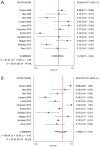Diagnostic value of urinary kidney injury molecule 1 for acute kidney injury: a meta-analysis
- PMID: 24404151
- PMCID: PMC3880280
- DOI: 10.1371/journal.pone.0084131
Diagnostic value of urinary kidney injury molecule 1 for acute kidney injury: a meta-analysis
Abstract
Background: Urinary Kidney Injury Molecule 1 (KIM-1) is a proximal tubular injury biomarker for early detection of acute kidney injury (AKI), with variable performance characteristics depending on clinical and population settings.
Methods: Meta-analysis was performed to assess the diagnostic value of urinary KIM-1 in AKI. Relevant studies were searched from MEDLINE, EMBASE, Pubmed, Elsevier Science Direct, Scopus, Web of Science, Google Scholar and Cochrane Library. Meta-analysis methods were used to pool sensitivity and specificity and to construct summary receiver operating characteristic (SROC) curves.
Results: A total of 2979 patients from 11 eligible studies were enrolled in the analysis. Five prospective cohorts, two cross-sectional and four case-control studies were identified for meta-analysis. The estimated sensitivity of urinary KIM-1 for the diagnosis of AKI was 74.0% (95% CI, 61.0%-84.0%), and specificity was 86.0% (95% CI, 74.0%-93.0%). The SROC analysis showed an area under the curve of 0.86(0.83-0.89). Subgroup analysis suggested that population settings and detection time were the key factors affecting the efficiency of KIM-1 for AKI diagnosis.
Limitation: Various population settings, different definition of AKI and Serum creatinine level used as the standard might have influence on AKI diagnosis. The relatively small number of studies and heterogeneity between them also affected the evaluation.
Conclusion: Urinary KIM-1 may be a promising biomarker for early detection of AKI with considerable predictive value, especially for cardiac surgery patients, and its potential value needs to be validated in large studies and across a broader scope of clinical settings.
Conflict of interest statement
Figures





Similar articles
-
Diagnostic performance of urinary kidney injury molecule-1 and neutrophil gelatinase-associated lipocalin for acute kidney injury in an obstructive nephropathy patient.Nephrology (Carlton). 2014 Apr;19(4):186-94. doi: 10.1111/nep.12173. Nephrology (Carlton). 2014. PMID: 24165570
-
Assessment of urinary kidney injury molecule-1 and interleukin-18 in the early post-burn period to predict acute kidney injury for various degrees of burn injury.BMC Nephrol. 2015 Aug 18;16:142. doi: 10.1186/s12882-015-0140-3. BMC Nephrol. 2015. PMID: 26283194 Free PMC article.
-
Time of injury affects urinary biomarker predictive values for acute kidney injury in critically ill, non-septic patients.BMC Nephrol. 2013 Dec 9;14:273. doi: 10.1186/1471-2369-14-273. BMC Nephrol. 2013. PMID: 24321290 Free PMC article.
-
Urinary and serum biomarkers for the diagnosis of acute kidney injury: an in-depth review of the literature.Nephrol Dial Transplant. 2013 Feb;28(2):254-73. doi: 10.1093/ndt/gfs380. Epub 2012 Oct 31. Nephrol Dial Transplant. 2013. PMID: 23115326 Review.
-
Biomarkers for the diagnosis of sepsis-associated acute kidney injury: systematic review and meta-analysis.Ann Palliat Med. 2021 Apr;10(4):4159-4173. doi: 10.21037/apm-20-1855. Epub 2021 Mar 22. Ann Palliat Med. 2021. PMID: 33832292
Cited by
-
The Predictive Value of Urinary Kidney Injury Molecular 1 for the Diagnosis of Contrast-Induced Acute Kidney Injury after Cardiac Catheterization: A Meta-Analysis.J Interv Cardiol. 2020 Aug 13;2020:4982987. doi: 10.1155/2020/4982987. eCollection 2020. J Interv Cardiol. 2020. PMID: 32863790 Free PMC article.
-
Potential Prognostic Markers of Acute Kidney Injury in the Early Phase of Acute Pancreatitis.Int J Mol Sci. 2019 Jul 30;20(15):3714. doi: 10.3390/ijms20153714. Int J Mol Sci. 2019. PMID: 31366007 Free PMC article. Review.
-
Acute kidney injury from sepsis: current concepts, epidemiology, pathophysiology, prevention and treatment.Kidney Int. 2019 Nov;96(5):1083-1099. doi: 10.1016/j.kint.2019.05.026. Epub 2019 Jun 7. Kidney Int. 2019. PMID: 31443997 Free PMC article. Review.
-
Transcriptome analysis of renal ischemia/reperfusion (I/R) injury in BAFF and BAFF-R deficient mice.PLoS One. 2023 Sep 26;18(9):e0291619. doi: 10.1371/journal.pone.0291619. eCollection 2023. PLoS One. 2023. PMID: 37751458 Free PMC article.
-
Prophylaxis of contrast-induced nephrotoxicity.Biomed Res Int. 2014;2014:308316. doi: 10.1155/2014/308316. Epub 2014 Apr 10. Biomed Res Int. 2014. PMID: 24812612 Free PMC article. Review.
References
-
- Ronco C, Levin A, Warnock DG, Mehta R, Kellum JA, et al. (2007) Improving outcomes from acute kidney injury (AKI): Report on an initiative. Int J Artif Organs 30: 373–376. - PubMed
-
- Webb S, Dobb G (2007) ARF, ATN or AKI? It’s now acute kidney injury. Anaesth Intensive Care 35: 843–844. - PubMed
-
- Li PK, Burdmann EA, Mehta RL (2013) Acute kidney injury: Acute kidney injury—global health alert. Nat Rev Nephrol 9: 133–135. - PubMed
-
- Lattanzio MR, Kopyt NP (2009) Acute kidney injury: new concepts in definition, diagnosis, pathophysiology, and treatment. J Am Osteopath Assoc 109: 13–19. - PubMed
-
- Perrone RD, Madias NE, Levey AS (1992) Serum creatinine as an index of renal function: new insights into old concepts. Clin Chem 38: 1933–1953. - PubMed
Publication types
MeSH terms
Substances
LinkOut - more resources
Full Text Sources
Other Literature Sources
Medical

